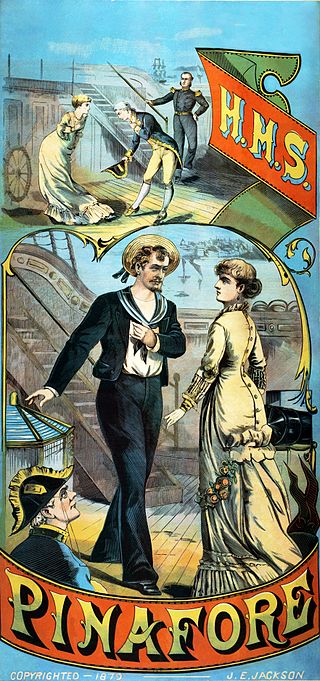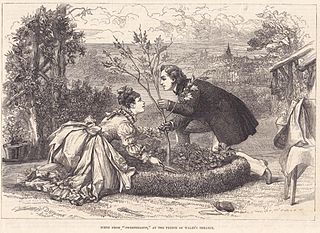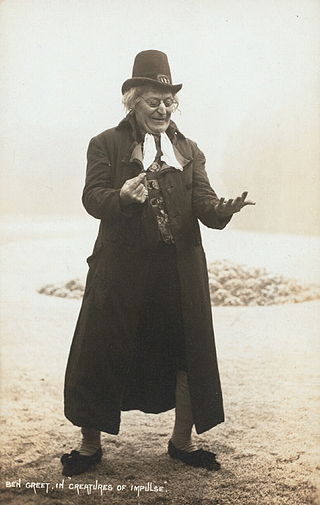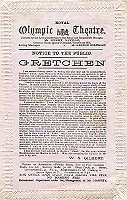
H.M.S. Pinafore; or, The Lass That Loved a Sailor is a comic opera in two acts, with music by Arthur Sullivan and a libretto by W. S. Gilbert. It opened at the Opera Comique in London on 25 May 1878, and ran for 571 performances, which was the second-longest run of any musical theatre piece up to that time. H.M.S. Pinafore was Gilbert and Sullivan's fourth operatic collaboration and their first international sensation.

Pygmalion and Galatea, an Original Mythological Comedy is a blank verse play by W. S. Gilbert in three acts based on the Pygmalion story. It opened at the Haymarket Theatre in London on 9 December 1871 and ran for a very successful 184 performances. It was revived many times, including an 1883 production in New York starring Mary Anderson as Galatea.

No Cards is a "musical piece in one act" for four characters, written by W. S. Gilbert, with music composed and arranged by Thomas German Reed. It was first produced at the Royal Gallery of Illustration, Lower Regent Street, London, under the management of German Reed, opening on 29 March 1869 and closing on 21 November 1869. The work is a domestic farce of mistaken identities and inept disguises, as two men desperately compete to marry a wealthy young lady. One is young and poor, and the other is a rich miser. Each disguises himself as her guardian.
This is a selected list of W. S. Gilbert's works, including all that have their own Wikipedia articles. For a complete list of Gilbert's dramatic works, see List of W. S. Gilbert dramatic works.

Dulcamara, or the Little Duck and the Great Quack, is one of the earliest plays written by W.S. Gilbert, his first solo stage success. The work is a musical burlesque of Donizetti's L'Elisir d'Amore, and the music was arranged by Mr. Van Hamme. It opened at the St James's Theatre on 29 December 1866, the last item in a long evening, following a farce and Dion Boucicault's new play Hunted Down. Dulcamara ran for a successful 120 nights.

Charity is a drama in four acts by W. S. Gilbert that explores the issue of a woman who had lived with a man as his wife without ever having married. The play analyses and critiques the double standard in the Victorian era concerning the treatment of men and women who had sex outside of marriage, anticipating the "problem plays" of Shaw and Ibsen. It opened on 3 January 1874 at the Haymarket Theatre in London, where Gilbert had previously presented his 'fairy comedies' The Palace of Truth, Pygmalion and Galatea, and The Wicked World. Charity ran for about 61 performances, closing on 14 March 1874, and received tours and revivals thereafter.
Broken Hearts is a blank verse play by W. S. Gilbert in three acts styled "An entirely original fairy play". It opened at the Royal Court Theatre in London on 9 December 1875, running for three months, and toured the provinces in 1876. It was revived at the Savoy Theatre in 1882. Julia Gwynne played Melthusine. It was revived again in 1883, and yet again in 1888 starring Marion Terry in February and Julia Neilson in May, and also at Crystal Palace that year. There was also a New York City production at the Madison Square Theatre.

The Realm of Joy is a one-act farce by W. S. Gilbert, writing under the pseudonym "F. Latour Tomline". It opened at the Royalty Theatre on 18 October 1873, running for about 113 performances, until 27 February 1874.

Sir William Schwenck Gilbert was an English dramatist, librettist, poet and illustrator best known for his collaboration with composer Arthur Sullivan, which produced fourteen comic operas. The most famous of these include H.M.S. Pinafore, The Pirates of Penzance and one of the most frequently performed works in the history of musical theatre, The Mikado. The popularity of these works was supported for over a century by year-round performances of them, in Britain and abroad, by the repertory company that Gilbert, Sullivan and their producer Richard D'Oyly Carte founded, the D'Oyly Carte Opera Company. These Savoy operas are still frequently performed in the English-speaking world and beyond.

Sweethearts is a comic play billed as a "dramatic contrast" in two acts by W. S. Gilbert. The play tells a sentimental and ironic story of the differing recollections of a man and a woman about their last meeting together before being separated and reunited after 30 years.

The Wicked World is a blank verse play by W. S. Gilbert in three acts. It opened at the Haymarket Theatre on 4 January 1873 and ran for a successful 145 performances, closing on 21 June 1873. The play is an allegory loosely based on a short illustrated story of the same title by Gilbert, written in 1871 and published in Tom Hood's Comic Annual, about how pure fairies cope with a sudden introduction to them of "mortal love."

Dan'l Druce, Blacksmith is a play by W. S. Gilbert, styled "A Three-Act Drama of Puritan times". It opened at the Haymarket Theatre in London on 11 September 1876, starring Hermann Vezin, Johnston Forbes-Robertson and Marion Terry. The play was a success, running for about 100 performances and enjoying tours and several revivals. It was popular enough to be burlesqued in a contemporary work, Dan'l Tra-Duced, Tinker, at the Strand Theatre. In an 1894 revival, Nancy McIntosh played Dorothy.

Rosencrantz and Guildenstern, A Tragic Episode, in Three Tabloids is a short play by W. S. Gilbert that parodies William Shakespeare's Hamlet. The main characters in Gilbert's play are King Claudius and Queen Gertrude of Denmark, their son Prince Hamlet, the courtiers Rosencrantz and Guildenstern, and Ophelia.

Creatures of Impulse is a stage play by the English dramatist W. S. Gilbert, with music by the composer-conductor Alberto Randegger, which Gilbert adapted from his own short story. Both the play and the short story concern an unwanted and ill-tempered old fairy who enchants people to behave in a manner opposite to their natures, with farcical results.

The Gentleman in Black is a two-act comic opera written in 1870 with a libretto by W. S. Gilbert and music by Frederic Clay. The "musical comedietta" opened at the Charing Cross Theatre on 26 May 1870. It played for 26 performances, until the theatre closed at the end of the season. The plot involves body-switching, facilitated by the magical title character. It also involves two devices that Gilbert would re-use: baby-switching and a calendar oddity.

Gretchen is a tragic four-act play, in blank verse, written by W. S. Gilbert in 1878–79 based on Goethe's version of part of the Faust legend.

Randall's Thumb is a play by W. S. Gilbert that premièred in 1871 at the opening of Marie Litton's Royal Court Theatre in London. Its plot, based on a short story that Gilbert had published the year before, relates how the forger Randall blackmails the innocent Buckthorpe for a crime he did not commit, hence putting him "under Randall's thumb". In the play, several characters pretend to be different from their real selves, a theme to be repeated in later works by Gilbert. The play received mixed reviews but lasted for a successful 123 performances in its original London run.

May Fortescue was an English actress, singer and actor-manager of the Victorian era and a protégée of playwright W. S. Gilbert. She was a member of the D'Oyly Carte Opera Company from 1881 to 1883, when she left the company following her engagement to a nobleman, young Arthur Cairns, Lord Garmoyle. Cairns soon broke off the engagement under pressure from his friends, and Fortescue returned to the stage in leading roles.

Trial by Jury is a comic opera in one act, with music by Arthur Sullivan and libretto by W. S. Gilbert. It was first produced on 25 March 1875, at London's Royalty Theatre, where it initially ran for 131 performances and was considered a hit, receiving critical praise and outrunning its popular companion piece, Jacques Offenbach's La Périchole. The story concerns a "breach of promise of marriage" lawsuit in which the judge and legal system are the objects of lighthearted satire. Gilbert based the libretto of Trial by Jury on an operetta parody that he had written in 1868.
















